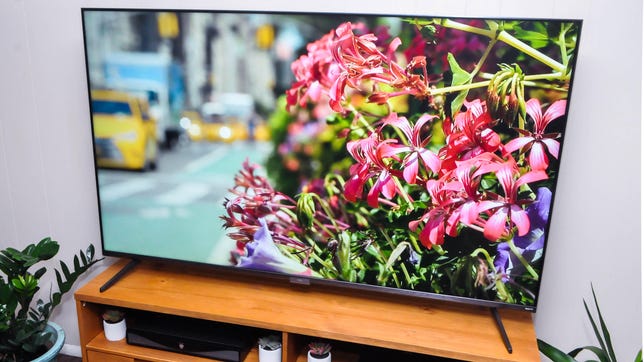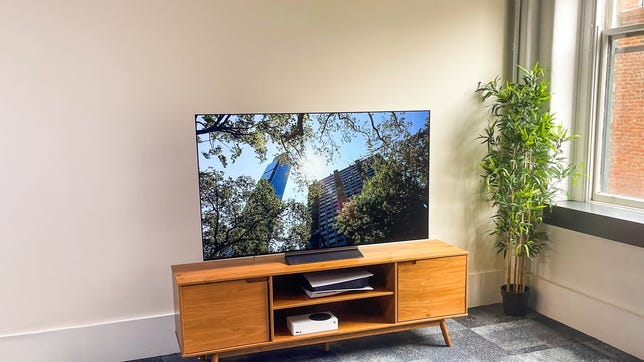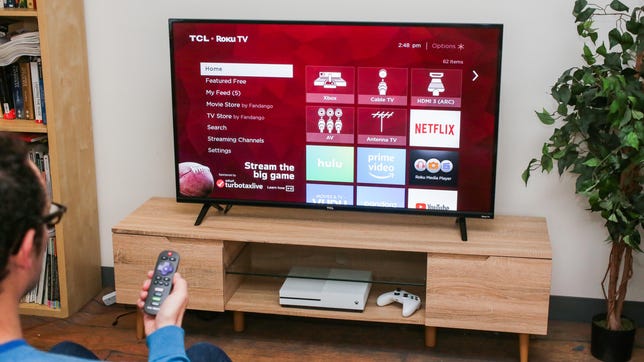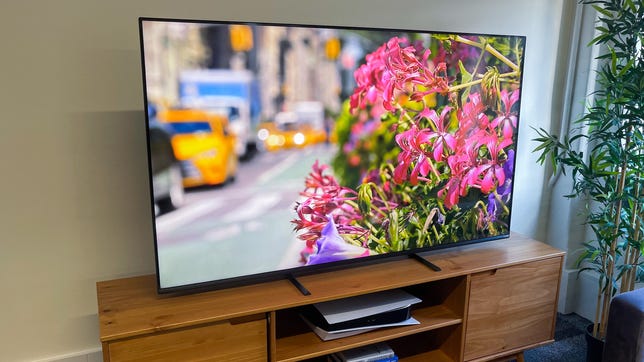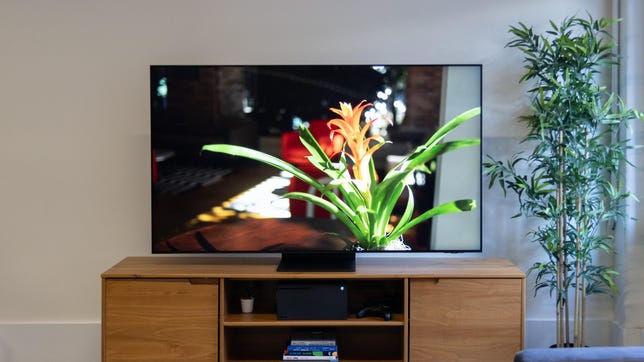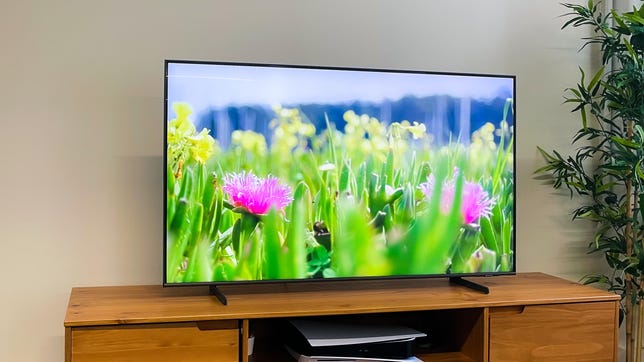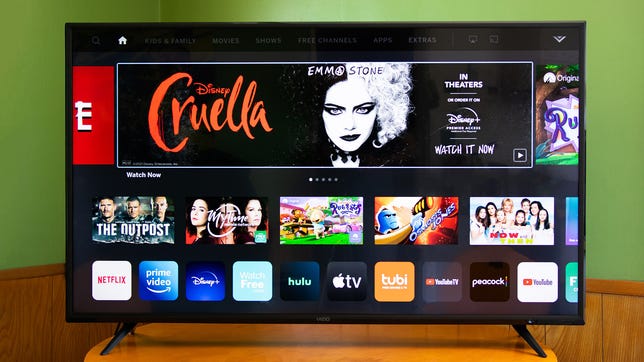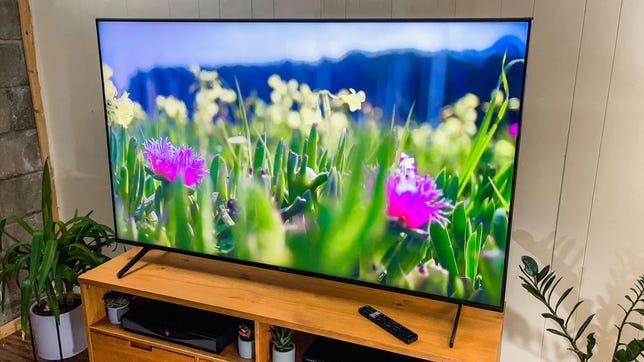[ad_1]
In this article:
With so many TVs on the market, buying a new one can be a daunting task.
The decision almost always comes down to price and the features you value most. One feature you’ll find on most modern TVs is 4K resolution support, which has become the predominant resolution in recent years — even the best TVs under $500 offer it.
The best 4K TVs encompass a wide variety of models at budget and premium prices. One of our favorite affordable models is the TCL 4-Series, which starts at less than $300 for a 43-inch model. For a more premium pick, we love the LG OLED C2 — just keep in mind that it can get pricey.
4K resolution just means the TV has a certain number of pixels, 3,840×2,160 to be exact, along with the ability to display 4K TV shows, movies and games from streaming services, devices and game consoles like the Xbox Series X and PS5.
There’s a lot more to picture quality than resolution, so you can’t ignore things like contrast, dynamic range, HDR performance and peak brightness. The best-performing TVs in our reviews excel in these areas. Additionally, if you’re looking for a gaming TV, you’ll also want to consider factors like input lag.
The list below represents the best 4K TVs (which are, let’s face it, the best TVs, period) that I’ve reviewed in CNET’s test lab, where I compare them side by side. Here are my latest recommendations, and for older models, I’ve included an “outlook” section with information on the new model.
Read more: Change These TV Settings for the Optimal Picture
Sarah Tew/CNET
Product details
Sizes
55-, 65-, 75-inch
TV Technology
QLED with Mini-LED
Smart TV
Yes (Roku TV)
Resolution
4K
HDMI Ports
4
No TV I’ve ever tested offers this much picture quality for as little cash. The TCL 6-Series Dolby Vision HDR TV has an excellent image thanks to mini-LED tech and well-implemented full-array local dimming that helps it run circles around just about any other TV at this price. It’s also a solid choice for gamers, with a THX mode that combines low input lag and high contrast. As if that’s not enough, the Roku TV operating system is our hands-down favorite.
This TV first came out in 2020 but is still a current model and remains my top choice. TCL also sells an 8K version of the 6-Series, but I don’t think it’s worth the extra money, as well as a Google-powered version I have yet to review (although according to TCL its image quality is the same as this Roku version).
Like:
Excellent overall image quality
Superior brightness for the price
Great game mode performance
Roku smart TV is simple, capable
Don’t like:
Some issues with low-light dimming
Key features:
Display technology: LED LCD (Mini-LED)
LED backlight: Full array with local dimming
Number of zones: 55-inch: 128; 65-inch: 160; 75-inch: 240
Resolution: 4K
Refresh rate: 120Hz
HDR compatible: HDR10 and Dolby Vision
Smart TV: Roku TV
Remote: Voice
HDMI support: 1440p/120Hz, VRR, eARC, ALLM
Sizes: 55-, 65-, 75-, 85-inch. (The prices shown below are for the 65-inch size.)
Outlook: The replacement for this TV is the TCL R655 series. We haven’t reviewed it yet, but according to TCL it should be brighter than this model with more local dimming zones, as well as offering 144Hz input capability for gaming and an improved stand design. Pricing between the two series is similar, with the exception of the 75-inch size which is more expensive in the newer model.
You’re receiving price alerts for TCL 6-Series
David Katzmaier/CNET
The C2 represents the pinnacle of picture quality at a price that’s admittedly high, but not too crazy. It beats any non-OLED TV on this list, including the Samsung QN90B below, with its perfect black levels, unbeatable contrast and superb off-angle viewing. It also has superb gaming features, making it the perfect companion to an Xbox Series X or S, PlayStation 5 or both. The C2 comes in a variety of sizes as well, although the bigger models are expensive.
Improvements over the C1 from 2021 include carbon-fiber construction for up to 47% lighter weight — the 65-inch version we reviewed weighs just 37 pounds with its stand, compared to 72 pounds for the 65-inch C1 — as well as some additional tweaks to game mode and a new “always ready” feature.
Like:
Better picture quality than any non-OLED TV
Superior contrast and off-angle image
Best-in-class gaming features
Sleek styling with ultralight, thin panel
Don’t Like:
Expensive
No major picture quality improvements over the C1 from 2021
Key features:
Display technology: OLED
LED backlight: N/A
Resolution: 4K
Refresh rate: 120Hz
HDR compatibility: HDR10 and Dolby Vision
Smart TV: Web OS
Remote: Motion
HDMI 2.1 support: 4K/120Hz, VRR, eARC, ALLM
Sizes: 42-, 48-, 55-, 65-, 77-, 83-inch. (The prices shown below are for the 65-inch size.)
You’re receiving price alerts for LG OLED C2
Sarah Tew/CNET
Product details
Sizes
43-, 50-, 55-, 65-, 75-, 85-inch
TV Technology
LED
Smart TV
Yes (Roku TV)
Resolution
4K
HDMI Ports
3
Roku is our favorite platform for live TV streaming services like Netflix, Hulu and Amazon Prime Video, and it’s even better baked into the TV. This TCL 4-Series can’t beat the models above on image quality — its 4K resolution and HDR performance don’t do much to help the picture — but it’s perfectly fine for most people, especially at this price.
We haven’t reviewed the latest version of this TV, the TCL S455 series, but it has similar specifications and we expect it to perform basically the same as the earlier model we did review.
Note that TCL also makes a Google TV and an Android TV version of the 4-Series. We haven’t reviewed them, but we expect similar picture quality to the Roku version.
Like:
Hard to beat the price
Easy-to-use Roku interface
Don’t like:
Cheap-feeling remote
Only average performance
HDR doesn’t look much better than SDR
Key features:
Display technology: LED LCD
LED backlight: Direct
Resolution: 4K
Refresh rate: 60Hz
HDR compatible: HDR10
Smart TV: Roku TV
Remote: Standard
HDMI support: ARC
Sizes: 43-, 50-, 55-, 65-, 75-, 85-inch. (The price shown below are for the 50-inch size.)
You’re receiving price alerts for TCL 4-Series
David Katzmaier
Product details
Sizes
50-, 65-, 75-inch
TV Technology
LED with local dimming
Smart TV
Yes (SmartCast)
Resolution
4K
HDMI Ports
4
The Vizio MQX is one of the least expensive TVs to feature full-array local dimming, which lets it reproduce TV shows, movies and games with enough contrast and pop to do HDR justice. The MQX has fewer dimming zones than more expensive TVs like the TCL 6-Series, but it offers 16 zones on the 50-inch, 30 on the 65-inch and 42 on the 75-inch, which is more than enough for excellent overall picture quality, with bright highlights, dark black levels, punchy contrast and accurate color.
Unlike the M7 from 2021, the MQX has a true 120Hz refresh rate, which allows compatibility with 4K/120Hz signals from game consoles like the Xbox Series X and PlayStation 5, and worked well in our tests. Vizio supports both major HDR formats, HDR10 and Dolby Vision, in the M-Series. If you can’t save up for the TCL 6-Series but want a better picture than the 4-Series, the Vizio MQX is an excellent happy medium.
Sizes: 50-, 65-, 75-inch.
You’re receiving price alerts for Vizio MQX
Bobby Oliver/CNET
Looking for a TV with spectacular image quality, but don’t want an OLED? The Samsung QN90B is your best bet. This TV uses QLED TV tech augmented by mini-LED for a brighter image than any OLED TV. The spectacular contrast of OLED still won out in our side-by-side tests, but the QN90B QLED screen comes closer than ever.
In summer 2022 the older version of this TV, the QN90A, remains on sale for hundreds less. It’s also an excellent performer but it’s slightly dimmer than the QN90B. It also lacks some of the 2022 model’s features, including the new game hub with cloud gaming.
Sizes: 43-, 50-, 55-, 65-, 75-, 85-inch. (The prices shown below are for the 65-inch size.)
You’re receiving price alerts for Samsung QN90B
James Martin/CNET
Product details
Sizes
43-, 50-, 55-, 60-, 65-, 70-, 75-, 85-inch
TV Technology
QLED
Smart TV
Yes (Tizen)
Resolution
4K
HDMI Ports
3
Samsung is the brand that sells more TVs than anyone, and one of its most popular is the Q60 series. Its sleek QLED screen design stands out compared with the other TVs on this list — even though the ultrathin OLED models are sleeker — and it offers better features, image quality and more sizes than models like the TCL 4-Series and Sony X80K. The TVs listed in this article are all superior values, but if you want a Samsung TV and can’t afford the QN90A, this is a great choice.
Note that the 2021 version, the Q60A, is still on sale and can be cheaper than the Q60B in some sizes. The newer version measured brighter in our tests, but if you want the best deal, stick with the Q60A if it’s still available.
Sizes: 43-, 50-, 55-, 60- 65-, 70- 75-, 85-inch. (The prices shown below are for the 55-inch size.)
You’re receiving price alerts for Samsung Q60B
Geoffrey Morrison/CNET
Product details
Sizes
43-, 50-, 55-, 60-, 65-, 70-, 75-, 85-inch
TV Technology
QLED
Smart TV
Yes (Tizen)
Resolution
4K
HDMI Ports
3
Vizio’s V-Series is our favorite budget alternative to the TCL 4-Series Roku TV. We liked Roku’s smart TV system better (sound familiar?), but the V-Series has some advantages, including a better remote with voice and more advanced picture settings. Picture quality between the two was basically the same, so if you don’t have a preference, it makes sense to get the cheapest one.
Like:
Excellent features for a low price
Voice remote with Bluetooth
Lots of picture adjustments
Don’t like:
Only average performance
HDR doesn’t look much better than SDR
Worse built-in streaming than Roku
Key features:
Display technology: LED LCD
LED backlight: Direct
Resolution: 4K
Refresh rate: 60Hz
HDR compatible: HDR10 and Dolby Vision
Smart TV: Smartcast
Remote: Voice
HDMI support: VRR (on V706-J and V756-J only), eARC
Sizes: 43-, 50-, 55-, 58- 65-, 75-inch. (The prices shown below are for the 55-inch size.)
Outlook: The 2022 version of the V-Series has very similar specifications and pricing as the 2021 series. We haven’t reviewed it yet but we expect the two to perform about the same.
You’re receiving price alerts for Vizio V-Series
David Katzmaier/CNET
With excellent picture quality, anchored by full-array local dimming and plenty of brightness to make HDR content shine, the X90J is Sony’s answer to the TCL 6-Series and step-up Vizio models. This LED TV’s sleek looks and the Google TV operating system score additional points, as does its next-gen console support — including variable refresh rate (VRR), enabled by a software update in March 2022 — and built-in NextGen TV tuner. This Sony TV is perfect for PS5 gaming and works with Alexa & Google Assistant. If you want an “S” brand, this is one of the best values we’ve tested.
Like:
Excellent image quality
Capable Google TV smart system
Solid connectivity
Subtle, understated design
Don’t like:
More expensive than competing TVs with similar picture quality
Key features:
Display technology: LED LCD
LED backlight: Full array with local dimming
Number of zones: Undisclosed
Resolution: 4K
Refresh rate: 120Hz
HDR compatible: HDR10 and Dolby Vision
Smart TV: Google TV
Remote: Voice
HDMI 2.1 support: 4K/120Hz, VRR, eARC, ALLM
Sizes: 50-inch, 55-inch, 65-inch, 75-inch. (The prices shown below are for the 65-inch size.)
Outlook: The successor to the X90J is the X90K. I haven’t reviewed the new model yet but its image quality specifications are largely similar to the 2021 version, so I don’t expect many picture quality differences. Unlike the 2021 version, the newer model ships with VRR enabled out of the box.
You’re receiving price alerts for Sony X90J Series
How does CNET test 4K TVs?
Our TV reviews follow a rigorous, unbiased evaluation process honed over nearly two decades of TV reviews. Our primary TV test lab has specialized equipment for measuring light and color, including a Konica Minolta CS-2000 spectroradiometer, a Murideo Sig-G 4K HDR signal generator and an AVPro Connect 8×8 4K HDR distribution matrix. We use Portrait Displays CalMan Ultimate software to evaluate every TV we review. In every CNET TV review, three or more similar TVs are compared side by side in various lighting conditions playing different media, including movies, TV shows and games, across a variety of test categories, from color to video processing to gaming to HDR. Our reviews also account for design, features, smart TV performance, HDMI input and gaming compatibility and other factors.
Read more: How We Test TVs
4K TV FAQs
I’ll post the answers to commonly asked TV questions below. If you have any others, feel free to reach out on Twitter (@dkatzmaier), or by clicking the little envelope icon on my CNET profile page. Doing so will let you send a message straight to my inbox.
How big a TV should I get?
In my opinion bigger is better, and your money is best spent on large screen sizes rather than a slight upgrade in image quality. The answer also depends on room size and seating distance: If you have a big room and sit farther away, you’ll want a bigger TV. The answer also depends on room size and seating distance.
Burn-in is when part of an image — for example a channel logo, news ticker or a scoreboard on a TV — persists as a ghostly background no matter what else appears onscreen. Burn-in is possible with any OLED TV, but it’s not likely with normal use. The best way to prevent burn-in is to vary what you watch.
What is the best smart TV system for streaming?
At CNET our favorite is Roku for its simplicity, but different systems like Google TV, Amazon Fire TV, Samsung and LG have different strengths, in particular for voice commands. In any case we don’t consider the built-in smart TV system that important because you can always connect a streaming device to any TV.
How do I get the best TV sound?
Most TVs sound terrible because their thin cabinets don’t have room for decent-size speakers or bass. If you want to get good sound you should buy an external audio system. Even an inexpensive soundbar will deliver much better audio quality than a TV’s built-in speakers.
More home entertainment recommendations
[ad_2]

